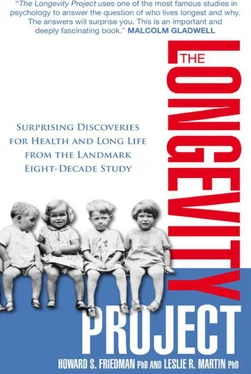The initial results were amazing. There was definitely some consistency in physical activity levels throughout life. Many people became more active over time and many became less active, but overall there was stability. For example, the parent ratings of their child’s energy and activities when he or she was around age eleven or twelve were predictive of activity levels of their hobbies decades later. 46 46 Read more about patterns of physical activity over time in H. S. Friedman, L. R. Martin, J. S. Tucker, M. H. Criqui, M. L. Kern, and C. Reynolds, “Stability of Physical Activity across the Lifespan,” Journal of Health Psychology 13 (2008): 966-78.
John, who became the shy physicist and lived a long life, loved to bicycle and swim at age twelve and loved skiing in the Sierras at age forty-one. Linda was active in both childhood and adulthood; a sociable child, her favorite pastimes in 1922, in addition to playing with dolls, included hopscotch, bouncing a ball, and other outdoor games. Later on she reported dancing, gardening, and tennis as her favorite hobbies and gravitated toward pursuits involving physical exertion.
Some of the patterns, like Donna’s, were much more sedentary. As a preteen Donna preferred to spend time playing chess or working on her collections—she had a large assemblage of railroad artifacts, as well as many marbles and arrowheads. Only sometimes did she play actively outside. In high school she became quite a sports enthusiast—but only as a spectator! And in 1950 she listed watching sports and playing cards among her favorite leisure activities.
When designing treatments for a patient with tension headaches or for those who really need to lose weight, doctors surely ask about the duration of the person’s condition and for information about what activities and events make it better or worse. Were you overweight as a child? Do you regain lost weight? When did your headaches start? Are your headaches worse in the summer? Yet when on the topic of physical fitness, the doctor will rarely delve into childhood activities, ask about college sports, or look for other such patterns. Instead, the advice will usually be, “You should increase your exercise, maybe take up running or join an exercise class.” But there is a better way to proceed.
Fitness levels, it appears, are more personal than the general “exercise is good for you” mantra might suggest. All in all, the findings told us that it makes no sense to rely on generalizations—individuals, we found, are on their own activity paths. The edict to exercise rigorously needs to be altered and tailored person to person.
METs (Activity) Across the Decades
The metabolic equivalents—the physical activity levels—varied quite a lot among the Terman subjects and across the decades. The men were, on average, more active than the women, but there were many individual patterns. Some were active as children and stayed very active, while others who crocheted and played croquet as children grew up to sew, play cards, and socialize as adults.
There was a decline in physical activity for most of the Terman participants after the teenage years and college, but it then seemed to stabilize and level off. Unsurprisingly, activity gradually decreased as the participants aged but often did not diminish substantially until old age. Even here, it was somewhat different for each individual. By 1972 Linda was no longer playing tennis, but she did continue to garden. John, however, was still quite physically active—now in his sixties he was still skiing. He described his energy and vitality by noting: “Vigorous; have considerable endurance.”
Over the next decade plus, the same trends continued for these two—Linda stayed actively engaged in life (she said that she had enough energy for a “full program of activities”), but her actual physical activity continued to decline slowly and by 1986 she worked in her garden only occasionally, spending most of her free time meeting with social groups and visiting informally with friends and neighbors. She also listed a daily nap among her activities. John was unusual—his decrease in physical activity was hardly even noticeable. At each assessment he listed a number of activities, and by 1986 John was still skiing occasionally, walking or hiking frequently, and even cutting his own firewood.
The children who were more sociable—that is, who were popular, often a leader, liked being in large groups, and liked playing with others—generally grew up to be more active adults. This social tendency worked to help them stay involved in sports. But over long periods of years, they tended to decrease their activity levels, so that by the time they reached their sixties, they were no longer more active than their less sociable counterparts. This was especially true for the men in the group, who may have gradually lost contact with organized sports.
The children who were energetic grew up to be adults who were energetic. They were also happier and better adjusted, based on midlife assessments. But for most, by the time they reached their sixties, they, too, looked pretty much like the other Terman participants—no longer significantly more active. Again the pressures of everyday life had limited and homogenized the hobbies. The skiers had become golfers, and the swimmers had become shoppers.
What about the sensitive worriers, those who were lacking in self-confidence? Those who were more neurotic were less likely to be physically active as children and even more unlikely to remain physically active as adults. They tended to avoid rigorous activity, both as children and as adults. They would not go tearing down the ski slopes no matter how many messages they received to get out and exercise.
There were exceptions. James, who was sensitive to the reactions of others in childhood and certainly qualified as one of the more neurotic Terman subjects in adulthood, nonetheless was fairly active throughout his life. Although he didn’t take many risks, he did get out and do things. In high school he was on the track team, and he channeled his love for plays into an active role doing stage work and lighting, which can be quite strenuous. As an adult he remained active. His involvement with plays eventually extended only to watching them, but he did continue with the woodworking he had learned in high school. He also enjoyed hiking, birdwatching, and swimming. And, in late life, he was one who specifically noted that he was making an effort to exercise and eat healthfully.
Physical Activity and Long Life
When we looked across the decades, we found that being active in middle age was most important to health and longevity. Being a childhood jock did not lead to long life if you were one of those who quit sports and slowed down a lot as you aged. On the other hand, being inactive in childhood was not a problem if you became more active as you aged. Those who were active in youth and stayed active tended to live very long lives, as was the case with James. Those who were inactive in youth and became more active often did almost as well in terms of life span, and sometimes equally well.
Those who were active were more likely to stay active, but if they did not, their risk of dying increased substantially. The good news for those seeking long life is that physical activity levels improved for many folks over time. Those sedentary desk jockeys who managed to bring out their inner athlete and move their bodies were able to catch up to or even surpass the health of their more naturally active peers.
There is a dirty little secret known to health professionals that they do not usually much talk about. Let’s assume that you follow the recommendations of a health authority and get out there most days to go jogging, even though you would much rather be doing something else. Say you get ready, warm up, jog, and cool down for about an hour a day, which is a modest regimen.
Читать дальше











